Abstract
This study aimed to assess the phenotypic and histological characteristics of leaves, stems, and roots of sweet potato (‘Hopungmi’ and ‘Sodammi’, Korean cultivars) under the low-temperature conditions induced by early transplanting. In leaves, early transplanting (ETP) led to reductions in vascular bundle width (from −22.6% to −53.7%), xylem diameter (from −51.6% to −52.6%), palisade parenchyma thickness (from −31.3% to −31.5%), and the palisade parenchyma thickness-to-leaf thickness ratio (from −31.2% to −32.1%), while the total leaf thickness remained unchanged. Principal component 1 (PC1: 69.7%) was positively correlated with vascular characteristics and palisade parenchyma thickness, reflecting enhanced development under optimal transplanting (OTP) and greater photosynthetic capacity. These findings indicate that low temperatures hinder palisade parenchyma development. In stems, ETP reduced stem radius (from −20.3% to −42.1%) and the pith-to-stem radius ratio (from −21.0% to −25.3%) but increased the xylem-to-stem radius ratio (from +45.8% to +47.1%) and the collenchyma-to-stem radius ratio (from +61.5% to +84.7%). PC1 (45.7%) showed positive correlations with xylem and collenchyma ratios and negative correlations with stem radius and pith ratio, suggesting that these anatomical adjustments helped maintain stem rigidity under stress. In roots, ETP significantly reduced root radius (from −78.0% to −94.5%), vascular radius (from −83.9% to −96.9%), cortex thickness (from −68.9% to −80.7%), and the vascular-to-root radius ratio (from −28.6% to −44.7%), while increasing the cortex-to-root radius ratio (from +53.0% to +248.0%). PC1 (93.8%) was positively associated with vascular characteristics and cortex thickness and negatively associated with the cortex-to-root radius ratio. Overall, the low temperatures resulting from early transplanting altered the anatomical structures of leaves, stems, and roots, indicating suboptimal conditions for storage root development. In particular, the vascular bundle radius of sweet potato roots was identified as a crucial indicator for evaluating storage root development, which can be utilized in future breeding strategies.
1. Introduction
Sweet potatoes, a tropical crop, are cultivated globally with an annual production of approximately 93.5 million tons, serving as a valuable starch source for both human consumption and livestock feed [1,2]. Among Asian countries, China leads in production, while Africa is a significant global contributor. However, South America, including countries such as Mexico and Colombia, is considered the primary center of origin [3].
In sweet potato production, the development of storage roots is essential, with their quantity playing a pivotal role in increasing yield [4,5,6]. The formation of storage roots is regulated by the maturity of the storage parenchyma in fibrous roots and the extent of starch accumulation [7,8]. Conversely, the poor development of storage parenchyma and fluctuations in starch accumulation can reduce yield potential by inhibiting xylem formation and increasing lignin deposition [8,9]. This storage root formation is influenced by hormonal regulation, gene expression, and abiotic stresses [8,10,11,12].
Sweet potato yields improve when cutting slips are used for transplanting, as this method also aids in disease and pest prevention [13,14]. After transplanting, a stable cultural environment supports yield improvement by promoting consistent growth of sweet potato slips [15,16,17]. However, abiotic stresses like high temperatures and drought hinder fibrous root development and storage root formation, while cold conditions adversely affect root elongation and starch accumulation [12,18]. As temperatures fluctuate due to climate change, the transplanting period for sweet potato in South Korea is changing [19,20]. Therefore, research on the optimal transplanting period is needed for stable sweet potato production.
Early transplanting has been practiced in South Korea to extend the cultivation period, reduce pest and disease incidence, and enhance economic returns [21,22,23]. Additionally, research is being conducted on the morphological, physiological, and biochemical characteristics of sweet potatoes for extending the transplanting period in South Korea [19,24,25]. However, research from a histological perspective is still necessary. In this study, we investigated histological and physiological damage in leaves, stems, and roots under the low-temperature conditions caused by early transplanting, compared to conventional transplanting.
2. Materials and Methods
2.1. Plant Materials and Cultivation Conditions
Two Korean sweet potato cultivars were used to evaluate low-temperature-induced damage during the early growth period of storage root development. The first cultivar, ‘Hopungmi’, was revealed in 2022, and the second, ‘Sodammi’, in 2021. ‘Hopungmi’ and ‘Sodammi’ exhibit higher yield potential under early and optimal transplanting conditions, respectively [26,27]. The experiment was conducted to investigate variations in growth responses according to transplanting periods in upland field conditions. Early transplanting was performed on 20 March 2023 to induce low-temperature stress, and optimal transplanting was carried out on 11 May 2023 to provide the optimal temperature for the initiation and development of storage roots [12]. To improve slip survival rates, black polyethylene film mulching was applied 14 days after early transplanting and 3 days after optimal transplanting. Daily average air temperature data were obtained from the Korea Meteorological Administration, with hourly measurements [28]. Soil temperature was recorded every 30 min at 5 cm and 10 cm depths using a temperature sensor (RC-4 Temperature Data Logger, Elitech Technology Inc., San Jose, CA, USA). Daily average air and soil temperatures were calculated from the mean of the average daily recordings. Temperature monitoring was continued for seven weeks after transplanting.
2.2. Measurement of Early Growth Characteristics and Harvest Indexes
We evaluated the damage of low temperature on growth characteristics seven weeks after transplanting. To assess these traits, the length and width of leaves (n = 10), stem diameter and length (n = 10), SPAD (soil plant analysis development) index (n = 5), and stomatal features—including stomatal length, width (n = 3), and density (n = 3)—on both adaxial and abaxial leaf surfaces were measured [29]. Leaf characteristics, SPAD index, and stomatal characteristics were assessed on the third leaf from the main stem’s shoot tip. The main stem length was measured from the ground surface to the shoot tip, and its diameter was measured at one-third of the height from the ground surface. The SPAD index was recorded using a SPAD-502 PLUS (Konica Minolta Sensing, Sakai, Japan). Stomatal characteristics were observed and measured using phase-contrast microscopy (Bx53 with DP-22, Olympus, Hachioji, Japan) at 100× magnification, while other traits were measured using vernier calipers.
Harvest indices were analyzed to assess the impact of low temperature on storage root development at 120 days after transplanting. The measured parameters included the number, length, diameter, weight, and hardness of storage roots with a diameter of 20 mm or more. Storage root hardness was measured using a texture analyzer (CT3 Texture Analyzer, AMETEK BROOKFIELD, Middleborough, MA, USA) equipped with a TA4/1000 probe (pre-test speed: 2 mm·s−1; test speed: 1 mm·s−1), using 1 cm3 blocks taken from the central part of the thickest storage root tissue. All harvest index measurements were conducted with three biological replicates.
2.3. Microanatomy-Based Histological Evaluation
To examine histological characteristics, leaf, stem, and root tissue were sampled seven weeks after transplanting for each transplanting period. Tissues were fixed in formalin-aceto-alcohol (Ricca Chemical Company, Arlington, TX, USA) for four weeks. Samples were dehydrated in 80% ethanol for 2 h, 90% ethanol for 2 h, and 99% ethanol for 12 h. They were then cleared in xylene for 4 h and embedded in paraffin at 65 °C for 6 h. Paraffin blocks were sectioned to a thickness of 15 µm using a microtome (Minux S700 Rotary Microtome; RWD Life Science, Shenzhen, China).
Following sectioning, samples were deparaffinized at 65 °C for 30 min using a slide warmer (XH-2016, Roundfin, Shenyang, China) and subsequently immersed in xylene for 1 h. Rehydration was performed sequentially with 99% ethanol for 20 min, 90% ethanol for 5 min, 70% ethanol for 1 min, and 50% ethanol for 1 min. Samples were then stained with a 0.5% safranin O solution for 5 min, rinsed in tap water for 5 min, stained with a 0.25% fast green solution for another 5 min, and again washed in tap water for 5 min [11]. In leaves, the following anatomical features were measured: total leaf thickness, midrib thickness and width, vascular bundle thickness and width, xylem diameter, and palisade parenchyma thickness. In stems, measurements included stem radius, pith radius, xylem thickness, phloem thickness, and collenchyma thickness. In roots, root radius, cambium radius, and cortex thickness were recorded. Leaf measurements were taken from the third leaf from the growth point of the main stem. Stem characteristics were assessed at one-third the height of the main stem from the soil surface. Root features were measured at the thickest part of the root. All histological characteristics were examined and measured in three replicates using phase-contrast microscopy (Bx53 with DP-22, Olympus, Japan) at 20×, 100×, and 200× magnifications.
2.4. Statistical Analysis
Analysis of variance (ANOVA) and principal component analysis (PCA) were conducted using the statistical software Analyse-it (ver. 6.15, Analyse-it Software Ltd., Leeds, UK). A two-way ANOVA was performed using the ANOVA function within the Fit Model menu, and the test was set as Partial F. The PCA plot was generated using the bi-plot function in the Multivariate menu, and the lambda scale was set to the average distance squared. All statistical analyses were conducted at a 5% significance level.
3. Results
3.1. Influence of Early Transplanting on Plant Morphology, SPAD Index, and Stomatal Traits
Daily average air and soil temperatures (at 5 and 10 cm depths) were recorded for seven weeks after transplanting. During the early transplanting period (ETP), both air and soil temperatures remained below 20 °C. In contrast, during the optimal transplanting period (OTP), both air and soil temperatures exceeded 20 °C after 23 days of transplantation (Figure 1).
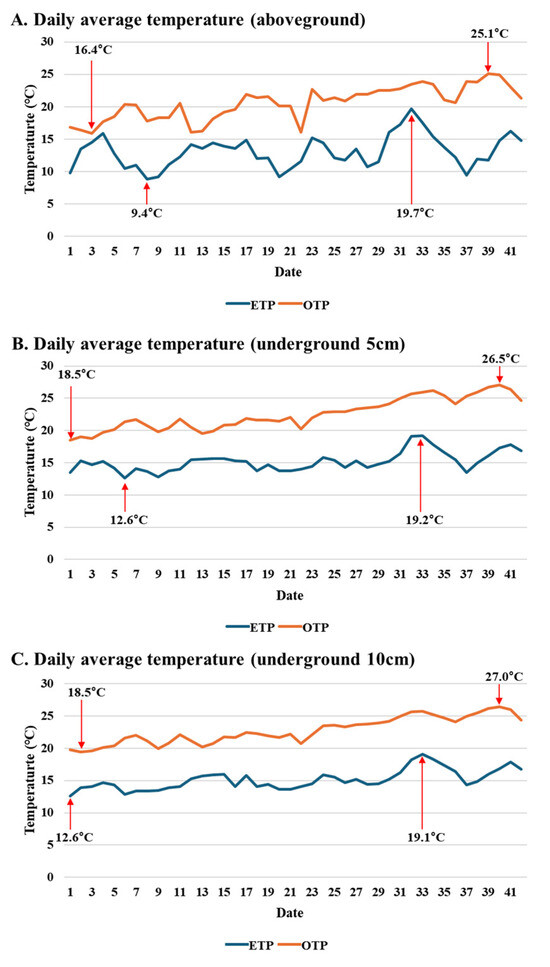
Figure 1.
Graph of daily average temperature for 42 days after transplanting. Average daily air temperature data of Jinju from the Korea Meteorological Administration (A) and measurement of soil temperature at 5 cm (B) and 10 cm (C) depth. Orange and blue lines indicate optimal and early transplanting periods, respectively.
Plant morphological traits—including leaf, stem, and root characteristics—along with SPAD index and stomatal attributes were examined to evaluate the impact of early transplanting during the early growth period (Figure 2, Figure 3 and Figure 4; Table 1 and Table 2). In both cultivars, ETP resulted in reduced growth of leaves, stems, and roots compared to OTP (Figure 2). Leaf length, leaf width, and stem diameter under ETP were reduced to 30.7–58.8% of the respective OTP values (‘Hopungmi’: 38.6 mm, 29.7 mm, and 23.1 mm; ‘Sodammi’: 40.6 mm, 30.7 mm, and 24.3 mm). Notably, stem length under ETP decreased by 94.9% (32.9 mm) in ‘Hopungmi’ and 92.7% (24.8 mm) in ‘Sodammi’. The sources of variation in leaf and stem growth characteristics were analyzed based on cultivar, transplanting period, and their interaction. Among these, the transplanting period emerged as the dominant factor influencing leaf length, leaf width, stem length, and stem diameter, accounting for 99.9%, 99.7%, 82.5%, and 99.8% of the total variation, respectively (Table 1). The SPAD index under the ETP was approximately 70% of the OTP, with values of 35.7 μmol·m−2 and 34.0 μmol·m−2 in ‘Hopungmi’ and ‘Sodammi’, respectively. On the adaxial side, stomatal length in ‘Sodammi’ decreased by 14.0% (28.76 μm), while stomatal width decreased by 6.4% (16.28 μm) and 13.2% (16.49 μm) in ‘Hopungmi’ and ‘Sodammi’, respectively. Stomatal density in ‘Hopungmi’ decreased by 29.3% (71.89 No./1.5 mm2). On the abaxial side, stomatal length in ‘Sodammi’ decreased by 11.1% (30.74 μm), whereas stomatal density increased in both cultivars.
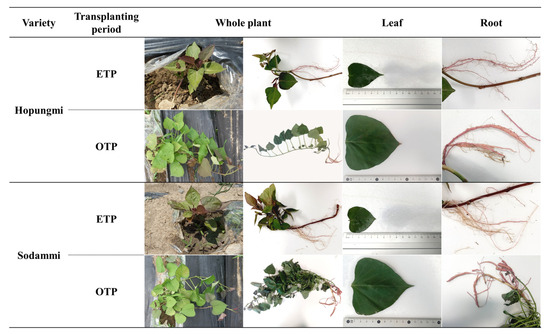
Figure 2.
Comparison of growth conditions under low and optimal temperatures according to early and optimal transplanting periods, respectively. ETP and OTP indicate early transplanting and optimal transplanting.
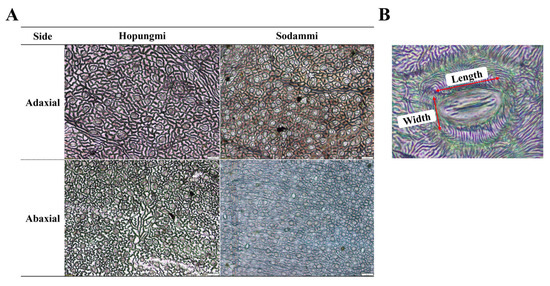
Figure 3.
Observation of stomata according to side and variety (A) and stomata structure (B).
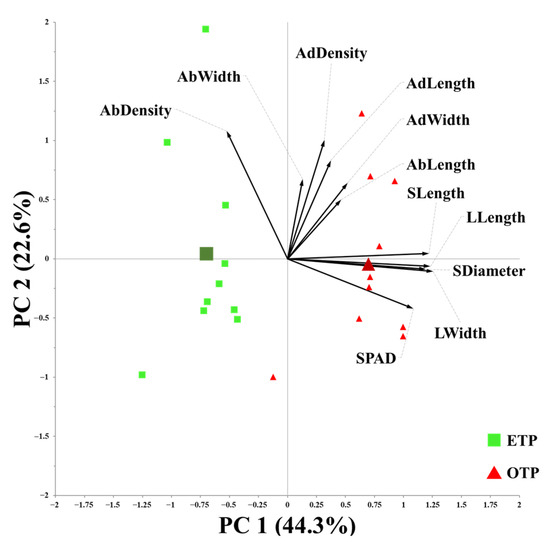
Figure 4.
Principal analysis of growth conditions such as leaf (L) length and width, and stem (S) length and diameter, as well as stomatal traits such as length, width, and density in adaxial (Ad) and abaxial (Ab) sides, according to two different transplanting periods. ETP and OTP indicate early and optimal transplanting periods, respectively. The large square and triangle indicate the average of ETP and OTP, respectively.

Table 1.
Evaluation of growth conditions according to different transplanting periods.

Table 2.
Evaluation of stomatal traits of adaxial and abaxial sides in early and optimal transplanting periods.
Sources of variation in SPAD index and stomatal characteristics were analyzed. For adaxial and abaxial stomatal length and abaxial stomatal width, the most significant source of variation was the interaction between cultivar and transplanting period, accounting for 55.5%, 51.6%, and 94.9% of total variation, respectively. The second most significant source of variation in stomatal length on both the adaxial and abaxial sides was the transplanting period, accounting for 42.8% and 37.1% of the total variation, respectively. Adaxial stomatal width and SPAD index showed that the primary source of variation was the transplanting period, contributing 71.0% and 89.4% of the total variation, respectively. Stomatal density on both the adaxial and abaxial sides indicated that the major source of variation was the variety, accounting for 90.4% and 84.2% of the total variation, respectively. Additionally, abaxial stomatal density identified the transplanting period as the second significant source of variation, contributing to 14.8% of the total variation (Table 2).
PCA was performed to examine the relationship among growth characteristics based on the transplanting period. Two principal components (PC1 and PC2) explained 66.9% of the total variation, with PC1 accounting for 44.3% and PC2 for 22.6%. Leaf length and width, stem length and diameter, and SPAD index were closely related and were developed in OTP plants. This indicates that the leaf and stem were not developed under low temperatures. Meanwhile, length, width, and density of stomata were also closely related and developed in a portion of OTP plants. These results indicate that the low temperatures inhibited not only leaf and stem growth but also the development of the stomatal characteristics (Figure 4).
3.2. Influence of Early Transplanting on Leaf Anatomical Characteristics
The leaf is anatomically structured with vascular tissue for water and nutrient transport and palisade parenchyma for photosynthesis (Figure 5). Leaf anatomical characteristics were examined to assess the effects of early transplanting during the early growth period (Figure 6 and Figure 7; Table 3). Under the ETP, both ‘Hopungmi’ and ‘Sodammi’ showed reductions in midrib and vascular bundle size (Figure 6). Leaf thickness was not significantly affected by transplanting period and variety. In ‘Hopungmi’, midrib thickness and width, vascular bundle thickness and width decreased by 50.8% (848.36 μm), 38.5% (823.69 μm), 66.3% (362.65 μm), and 53.7% (128.36 μm), respectively, under ETP (Table 3).
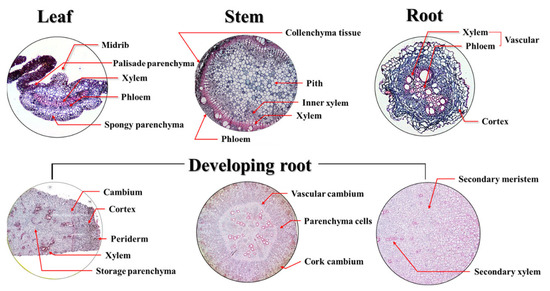
Figure 5.
Anatomical structure of leaf, stem, and root tissue.
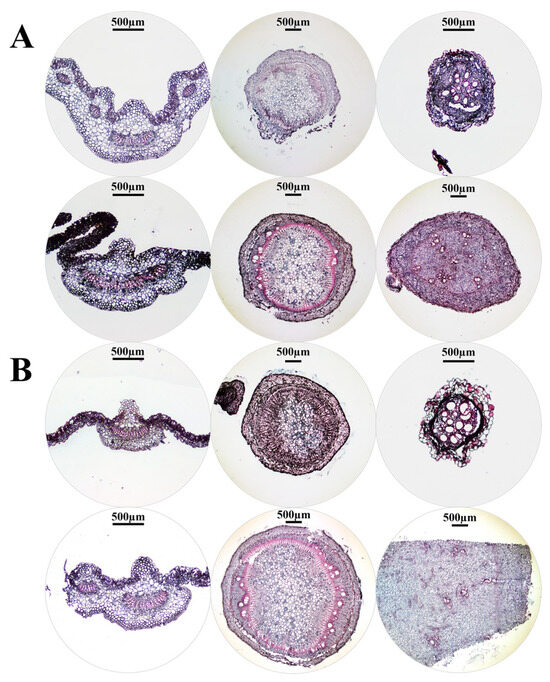
Figure 6.
Anatomical observation of tissues of leaf, stem, and root (left to right, respectively). ‘Hopungmi’ is above and ‘Sodammi’ is below according to early (A) and optimal (B) transplanting periods.
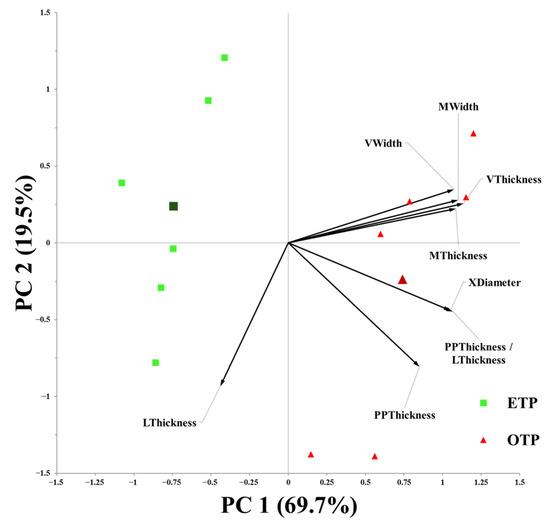
Figure 7.
Principal component analysis of leaf anatomical characteristics such as leaf (L) thickness, midrib (M) thickness and width, vascular (V) thickness and width, leaf xylem (LX) diameter, palisade parenchyma (PP) thickness, and PP thickness/L thickness ratio according to two different transplanting periods. ETP and OTP indicate early and optimal transplanting periods, respectively. The large square and triangle indicate the average of ETP and OTP, respectively.

Table 3.
Evaluation of leaf anatomical characteristics by transplanting periods and cultivars.
The xylem diameter was approximately 47–49% of the value in the OTP, with 19.83 μm in ‘Hopungmi’ and 18.94 μm in ‘Sodammi’. Palisade parenchyma thickness and the palisade parenchyma thickness-to-leaf thickness ratio were about 68–69% of those in OTP, measuring 86.02 μm and 34.0% in ‘Hopungmi’, and 79.42 μm and 31.7% in ‘Sodammi’ under ETP (Table 3). The sources of variation in leaf anatomical characteristics were also analyzed. The transplanting period was the dominant factor influencing midrib thickness, midrib width, vascular bundle thickness, vascular bundle width, xylem diameter, palisade parenchyma thickness, and the palisade parenchyma thickness-to-leaf thickness ratio, accounting for 72.4%, 71.8%, 70.4%, 74.1%, 99.1%, 95.3%, and 98.3% of the total variation, respectively. Leaf thickness, however, did not show any significant variation from any source (Table 3).
PCA was performed on leaf anatomical characteristics. PC1 (69.7%) and PC2 (19.5%) together explained 89.2% of the variation in the correlation between anatomical characteristics and their distribution among individuals. A close relationship was observed between midrib thickness and width and vascular thickness and width, and they developed in OTP plants. Additionally, palisade thickness and palisade parenchyma thickness-to-leaf thickness ratio were also related and developed in OTP plants. This suggested that the low temperatures inhibited the development of transport tissue and the primary tissue of photosynthesis (Figure 7).
3.3. Influence of Early Transplanting on Stem Anatomical Characteristics
The stem is anatomically composed of pith, xylem, and phloem for water and nutrient transport, along with collenchyma for structural support (Figure 5). Stem anatomical characteristics were examined to assess the effects of early transplanting during the early growth period (Figure 6 and Figure 8; Table 4). Under the ETP, both ‘Hopungmi’ and ‘Sodammi’ exhibited a thinner pith radius and a thicker xylem thickness (Figure 6). In ‘Hopungmi’, stem radius, pith radius, and the pith radius-to-stem radius ratio decreased by 20.3% (1443.92 μm), 40.9% (707.97 μm), and 25.2% (49.4%) under ETP, respectively. Conversely, the xylem thickness-to-stem radius ratio, phloem thickness-to-stem radius ratio, collenchyma thickness, and collenchyma thickness-to-stem radius ratio increased by 47.1% (to 17.8%), 22.2% (to 8.8%), 28.1% (342.62 μm), and 61.5% (to 23.9%), respectively. In ‘Sodammi’, stem radius, pith radius, pith radius-to-stem radius ratio, phloem thickness, and phloem thickness-to-stem radius ratio decreased by 42.1% (1327.01 μm), 54.8% (702.24 μm), 21.0% (53.3%), 51.9% (91.11 μm), and 16.9% (6.9%) under ETP. Meanwhile, the xylem thickness-to-stem radius ratio and the collenchyma thickness-to-stem radius ratio increased by 45.8% (to 15.6%) and 84.7% (to 24.2%), respectively. Xylem thickness itself was not significantly affected by ETP in either cultivar. The sources of variation in stem anatomical characteristics were analyzed. The stem radius, pith radius, xylem thickness, phloem thickness, collenchyma thickness, pith radius-to-stem radius ratio, xylem thickness-to-stem radius ratio, and collenchyma thickness-to-stem radius ratio were primarily influenced by the transplanting period, accounting for 72.4%, 71.8%, 70.4%, 74.1%, 79.9%, 97.9, 80.7, and 98.5% of the total variation, respectively. The most significant factor affecting the phloem thickness-to-stem radius ratio was the interaction between cultivar and transplanting period, which explained 91.8% of the total variation (Table 4).
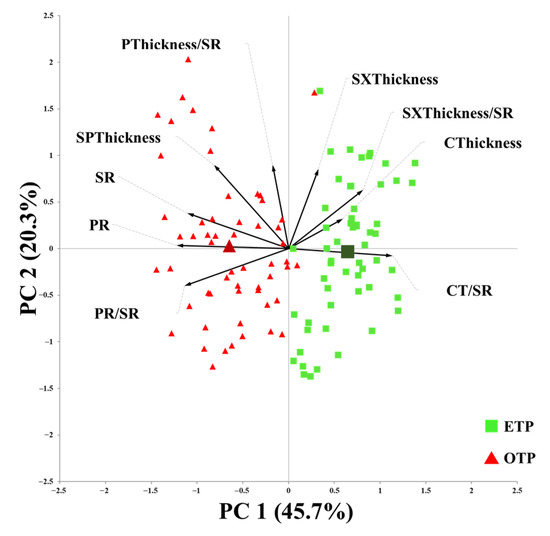
Figure 8.
Principal component analysis of stem anatomical characteristics such as stem radius (SR), pith radius (PR), stem xylem (SX) thickness, stem phloem (SP) thickness, collenchyma (C) thickness, PR/SR ratio, SX thickness/SR ratio, SP thickness/SR ratio, and C thickness/SR ratio according to two different transplanting periods. ETP and OTP indicate early and optimal transplanting periods, respectively. The large square and triangle indicate the average of ETP and OTP, respectively.

Table 4.
Evaluation of stem anatomical characteristics by transplanting periods and cultivars.
PCA was conducted on the stem anatomical characteristics. PC1 and PC2 explained 65.8% of the total variation, with PC1 accounting for 45.7% and PC2 for 20.3%. The stem radius, pith radius, pith radius-to-stem radius ratio, and phloem thickness were developed in OTP plants, while collenchyma thickness, collenchyma thickness-to-stem radius ratio, and xylem thickness were developed in ETP plants. This showed that the low temperatures hindered the development of sugar transport tissue but promoted the development of water transport tissue and structural tissue (Figure 8).
3.4. Influence of Early Transplanting on Root Anatomical Characteristics
Young fibrous roots exhibited developed vascular bundles, whereas developing storage roots displayed well-developed storage parenchyma (Figure 5). Root anatomical characteristics were assessed to evaluate the effects of early transplanting during early growth (Figure 6 and Figure 9; Table 5). Under ETP, both ‘Hopungmi’ and ‘Sodammi’ showed reduced differentiation of storage parenchyma and increased xylem development (Figure 6). In ‘Hopungmi’, root radius, vascular radius, cortex thickness, and vascular radius-to-root radius ratio decreased by 78.0% (401.59 μm), 83.9% (189.77 μm), 68.9% (203.66 μm), and 28.6% (46.5%), respectively. Meanwhile, the cortex thickness-to-root radius ratio increased 1.53-fold (to 53.5%). In ‘Sodammi’, root radius, vascular radius, cortex thickness, and vascular radius-to-root radius ratio decreased by 94.5% (378.07 μm), 96.9% (181.31 μm), 80.7% (200.98 μm), and 44.7% (46.8%), respectively, under ETP, while the cortex thickness-to-root radius ratio increased 3.48-fold (to 53.2%). The sources of variation in root anatomical characteristics were analyzed. The transplanting period was the major source of variation for root radius. The vascular radius, vascular radius-to-root radius ratio, cortex thickness, and cortex thickness-to-root radius ratio accounted for 55.5%, 50.7%, 84.9%, 80.7%, and 80.7% of the total variation, respectively (Table 5).
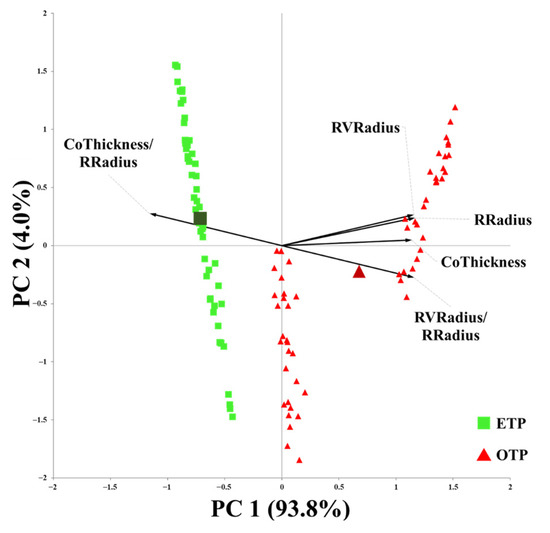
Figure 9.
Principal component analysis of root anatomical characteristics such as root (R) radius, root vascular (RV) radius, cortex (Co) thickness, and the ratio of RV radius/R radius and Co thickness/R radius according to two different transplanting periods. ETP and OTP indicate early and optimal transplanting periods, respectively. The large square and triangle indicate the average of ETP and OTP, respectively.

Table 5.
Evaluation of root anatomical characteristics by transplanting periods and cultivars.
PCA was also performed on root anatomical characteristics. PC1 and PC2 explained 97.8% of the variation, with PC1 contributing 93.8% and PC2 4.0%. The root radius, vascular radius, vascular radius-to-root radius ratio, and cortex thickness were related and developed in OTP plants, while the cortex thickness-to-root radius ratio was higher in ETP plants. This suggests that low temperatures inhibited the development of storage parenchyma for the accumulation of starch (Figure 9).
3.5. Influence of Early Transplanting on Harvest Index
The harvest index was assessed to determine the effect of early transplanting during the early growth stage (Figure 10 and Figure 11; Table 6). Under the ETP, both ‘Hopungmi’ and ‘Sodammi’ exhibited reduced storage root development and increased pencil root formation (Figure 10). In ‘Hopungmi’, the storage root diameter and the total storage root weight-to-root weight ratio decreased by 53.3% (28.53 mm) and 36.3% (54.3%), respectively. In ‘Sodammi’, the storage root length and total storage root weight were reduced by 48.0% (73.44 mm) and 91.7% (111.67 g), respectively, under ETP. The sources of variation in the harvest index were analyzed. The storage root length, storage root diameter, storage root number, storage root weight, root weight, total storage root weight-to-root weight ratio, and storage root hardness were primarily influenced by temperature. These traits accounted for 76.0%, 70.3%, 75.4%, 96.5%, 92.2%, 79.2%, and 89.7% of the total variation, respectively (Table 6).

Figure 10.
Observation of root development of two Korean sweet potato cultivars (‘Hopungmi’ on the left and ‘Sodammi’ on the right) according to early (A) and optimal (B) transplanting periods.
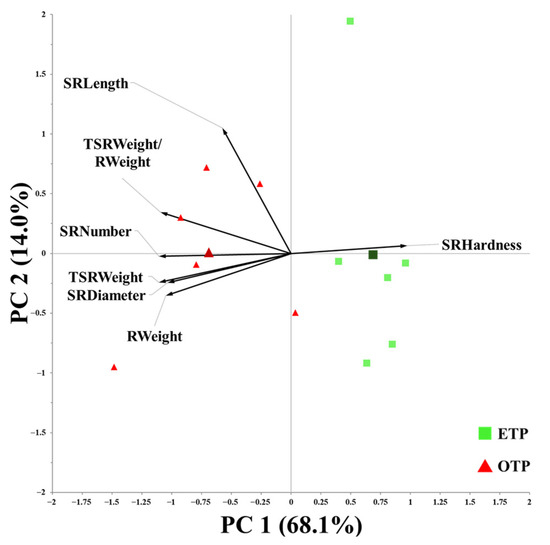
Figure 11.
Principal component analysis of harvest indices, namely storage root (SR) length, diameter, number, total weight, and hardness and root (R) weight, and the total storage root weight (TSRW)/ R weight according to two different transplanting periods. ETP and OTP indicate early and optimal transplanting periods, respectively.

Table 6.
Evaluation of harvest indices of two Korean sweet potato cultivars according to different transplanting periods.
PCA was conducted on the harvest index. PC1 and PC2 explained 82.1% of the variation, with PC1 accounting for 68.1% and PC2 for 14.0%. The diameter and number of storage roots, total storage root weight, root weight, and total storage root weight-to-root weight were related and developed in OPT plants, while the thickest storage root hardness was higher in ETP plants. This indicates that the low temperatures induced by the transplanting period inhibited yield traits and promoted root lignification (Figure 11).
4. Discussion
Low temperatures hinder sweet potato growth by restricting leaf development and photosynthetic efficiency, ultimately affecting sugar production essential for storage root formation. Sugars are synthesized through photosynthesis in chloroplasts located within the palisade parenchyma [30,31]. Prior studies have shown that early exposure to low temperatures reduces leaf size and photosynthetic rate [12]. In this experiment, both sweet potato cultivars showed not only reduced leaf growth and SPAD index but also diminished palisade parenchyma thickness and ratio during the ETP (Figure 6 and Figure 7; Table 3). These results indicate that low temperatures induced by early transplanting suppressed palisade parenchyma development, thereby decreasing photosynthetic capacity and limiting the sugar production necessary for storage root development. While the impact of low temperature on palisade parenchyma has been studied in other plant species, research on tuberous plants such as sweet potato, potato, and cassava remains limited [32].
Stem transports water required for photosynthesis via the xylem and delivers sugars essential for storage root development through the phloem [30,31]. The pith and cortex, as types of ground tissue, contribute structural support to the stem [31,33]. Earlier studies report that stem anatomy is altered under various stresses: salinity stress reduces pith and phloem development, nitrogen deficiency and drought suppress xylem development, and water deficit inhibits phloem development [34,35,36,37]. In this study, early transplanting inhibited stem growth and pith development while increasing the collenchyma thickness ratio in both cultivars (Figure 6 and Figure 8; Table 4). These findings imply that low temperatures during transplanting may impair sugar transport for storage root development and reduce the stem’s ability to support vascular bundles. By contrast, the impact of low temperature on stem tissue in other species remains limited.
This stress condition also inhibits storage root formation by suppressing the differentiation of storage parenchyma, which is essential for starch accumulation [9,38]. Earlier research has shown that low temperatures hinder the transition of fibrous roots into storage roots in sweet potato and inhibit stolon bulking and starch accumulation in potato [12,18,39]. In this study, storage roots failed to form in both cultivars under ETP conditions. Furthermore, the differentiation of storage parenchyma—responsible for starch accumulation—was inadequate, and xylem tissue developed in the central region instead (Figure 6 and Figure 9; Table 5). This inhibition was likely due to low-temperature stress that downregulated the genes related to starch biosynthesis and upregulated the genes related to lignin synthesis, thereby promoting root lignification [8,11].
5. Conclusions
This study confirmed that the low temperatures resulting from early transplanting suppressed the growth and histological characteristics of leaves, stems, and roots in sweet potato, thereby impeding storage root development. Consistent with previous findings that early growth is sensitive to low temperature, this study highlights the adverse effects of early transplanting on tissue structure and histological functions. The results indicate that the suppressed histological development during the early growth period can negatively impact storage root formation. Notably, for future breeding strategies, the vascular bundle radius of sweet potato roots can serve as a crucial indicator for evaluating storage root development. Moreover, early transplanting is suggested at a daily average temperature of 20 °C or higher to promote storage root development, balancing the benefits of an extended cultivation period against the risk of low-temperature damage [12].
In this study, black polyethylene film mulching was applied. This had the effect of increasing soil temperature, partially reducing low-temperature stress in the ETP. Nevertheless, tissue development inhibition due to low-temperature stress was clearly observed in the ETP. This demonstrates that despite the warming effect of mulching, low temperatures significantly impacted sweet potato growth. Further research is needed to investigate how the low temperatures induced by early transplanting affect the expression patterns of key transcription factors involved in lignin and starch biosynthesis across different cultivars and environmental conditions, as these ultimately regulate storage root enlargement.
Author Contributions
Conceptualization, S.O., S.-W.K., and S.-W.C.; methodology, S.O., S.-W.K., and S.-W.C.; validation, S.O., S.-W.K., and S.-W.C.; formal analysis, S.O. and S.-W.C.; investigation, S.O., S.-W.K., Y.L., and S.-W.C.; resources, J.-Y.K., J.M., and J.L.; data curation, S.O. and S.-W.C.; writing—original draft preparation, S.O.; writing—review and editing, S.O., S.-W.K., Y.L., J.O., G.R., S.L., and S.-W.C.; visualization, S.O. and S.-W.C.; supervision, S.-W.C.; project administration, T.-Y.H. and S.-W.C.; funding acquisition, T.-Y.H. and S.-W.C. All authors have read and agreed to the published version of the manuscript.
Funding
This research was funded by the Rural Development Administration of Korea, grant number RS-2023-00217877.
Data Availability Statement
The original contributions presented in the study are included in the article. Further inquiries can be directed to the corresponding author.
Conflicts of Interest
The authors declare no conflicts of interest.
Abbreviations
| SPAD | Soil plant analysis development |
| PCA | Principal component analysis |
| ETP | Early transplanting period |
| OTP | Optimal transplanting period |
| V | Variety |
| T | Transplanting period |
| L | Leaf |
| S | Stem |
| Ad | Adaxial |
| Ab | Abaxial |
| M | Midrib |
| V | Vascular |
| LX | Leaf xylem |
| PP | Palisade parenchyma |
| SR | Stem radius |
| PR | Pith radius |
| SX | Stem xylem |
| SP | Stem phloem |
| C | Collenchyma |
| R | Root |
| RV | Root vascular |
| Co | Cortex |
| SR | Storage root |
| TSRW | Total storage root weight |
References
- FAO. Available online: https://www.fao.org/faostat/en/#data/QCL (accessed on 11 March 2025).
- Mohanraj, R.; Sivasankar, S. Sweet potato (Ipomoea batatas [L.] Lam)—A valuable medicinal food: A review. J. Med. Food. 2014, 17, 733–741. [Google Scholar] [CrossRef]
- Cartabiano-Leite, C.E.; Porcu, O.M.; Casas, A.F. Sweet potato (Ipomoea batatas L. Lam) nutritional potential and social relevance: A review. IJERA 2020, 10, 23–40. [Google Scholar]
- Liang, Q.; Chen, H.; Chang, H.; Liu, Y.; Wang, Q.; Wu, J.; Liu, Y.; Kumar, S.; Chen, Y.; Chen, Y.; et al. Influence of planting density on sweet potato storage root formation by regulating carbohydrate and lignin metabolism. Agronomy 2023, 13, 2795. [Google Scholar] [CrossRef] [PubMed]
- Liu, B.K.; Xv, B.J.; Si, C.C.; Shi, W.Q.; Ding, G.Z.; Tang, L.X.; Xv, M.; Shi, C.Y.; Liu, H.Y. Effect of potassium fertilization on storage root number, yield, and appearance quality of sweet potato (Ipomoea batatas L.). Front. Plant Sci. 2024, 14, 1298739. [Google Scholar] [CrossRef] [PubMed]
- Meyers, S.L.; Shankle, M.W.; Main, J.; Gajanayake, B.; Reddy, K.R. Sweetpotato Storage Root Initiation; MSU Extension: East Lansing, MI, USA, 2014; p. 2809. [Google Scholar]
- He, S.; Wang, H.; Hao, X.; Wu, Y.; Bian, X.; Yin, M.; Chen, L. Dynamic network biomarker analysis discovers IbNAC083 in the initiation and regulation of sweet potato root storage rootization. Plant J. 2021, 108, 793–813. [Google Scholar] [CrossRef] [PubMed]
- Firon, N.; LaBonte, D.; Villordon, A.; Kfir, Y.; Solis, J.; Lapis, E.; Perlman, T.S.; Doron-Faigenboim, A.; Hetzroni, A.; Althan, L.; et al. Transcriptional profiling of sweetpotato (Ipomoea batatas) roots indicates down-regulation of lignin biosynthesis and up-regulation of starch biosynthesis at an early stage of storage root formation. BMC Genom. 2013, 14, 460. [Google Scholar] [CrossRef]
- Ravi, V.; Chakrabarti, S.K.; Makeshkumar, T.; Saravanan, R. Molecular Regulation of Storage Root Formation and Development in Sweet Potato. In Horticultural Reviews; Janick, J., Ed.; John Wiley & Sons: Hoboken, NJ, USA, 2014; Volume 42, pp. 157–207. [Google Scholar] [CrossRef]
- Dasgupta, M.; Sahoo, M.R.; Kole, P.C.; Mukherjee, A. Evaluation of orange-fleshed sweet potato (Ipomoea batatas L.) genotypes for salt tolerance through shoot apex culture under in vitro NaCl mediated salinity stress conditions. Plant Cell Tiss. Organ Cult. 2008, 94, 161–170. [Google Scholar] [CrossRef]
- Singh, V.; Sergeeva, L.; Ligterink, W.; Aloni, R.; Zemach, H.; Doron-Faigenboim, A.; Yang, J.; Zhang, P.; Shabtai, S.; Firon, N. Gibberellin Promotes Sweetpotato Root Vascular Lignification and Reduces Storage-Root Formation. Front. Plant Sci. 2019, 10, 1320. [Google Scholar] [CrossRef]
- Wijewardana, C.; Reddy, K.R.; Shankle, M.W.; Meyers, S.; Gao, W. Low and high-temperature effects on sweet potato storage root initiation and early transplant establishment. Sci. Hortic. 2018, 240, 38–48. [Google Scholar] [CrossRef]
- Xu, Y.; Wang, L.X.; Chen, C.; Ma, S.S.; Zhou, R.; Xiong, A.S. Virus-Free Sweet Potato Industry: Development Status and Production Suggestions. Horticulturae 2024, 10, 979. [Google Scholar] [CrossRef]
- Castory, K.; Khamadin, D.M.; Fred, T. Profit Analysis of Virus Free Sweet Potato and Vine Multiplication by Smallholder Farmers in Selected Regions of Tanzania. Int. J. Agric. Econ. 2020, 5, 99–105. [Google Scholar] [CrossRef]
- Gajanayake, B.; Reddy, K.R.; Shankle, M.W.; Arancibia, R.A.; Villordon, A.O. Quantifying storage root initiation, growth, and developmental responses of sweetpotato to early season temperature. Agron. J. 2014, 106, 1795–1804. [Google Scholar] [CrossRef]
- Nwanne, A.; Ikeh, A. Response of sweet potato (Ipomoea batatas (L.) lam) to organic soil amendment in an ultisol of southeastern Nigeria. J. Agron. Agric. Sci. 2020, 3, 019. [Google Scholar] [CrossRef]
- Dumbuya, G.; Alemayehu, H.A.; Hasan, M.M.; Matsunami, M.; Shimono, H. Effect of soil temperature on growth and yield of sweet potato (Ipomoea batatas L.) under cool climate. J. Agric. Meteorol. 2021, 77, 118–127. [Google Scholar] [CrossRef]
- Yooyongwech, S.; Samphumphuang, T.; Tisarum, R.; Theerawitaya, C.; Cha-um, S. Water-Deficit Tolerance in Sweet Potato [Ipomoea batatas (L.) Lam.] by Foliar Application of Paclobutrazol: Role of Soluble Sugar and Free Proline. Front. Plant Sci. 2017, 8, 1400. [Google Scholar] [CrossRef] [PubMed]
- Baek, E.S.; Hwang, E.B.; Nam, D.G.; Yoo, H.S.; Gwak, S.C.; Jeong, H.S.; Oh, S.J.; Cho, S.W.; Yu, J.K.; Hwang, T.Y. Optimizing transplanting and harvesting dates for ‘‘Hopungmi’’ sweet potato (Ipomoea batatas L.) in Yeoju under climate change. J. Crop Sci. Biotechnol. 2025. [Google Scholar] [CrossRef]
- NIMS. Hanbando Gihubyeonhwa Jeonmangbogoseo 2020: SSP1-2.6/SSP5-8.5e Ttareun Gihubyeonhwa Jeonmang [Korean Peninsula Climate Change Outlook Report 2020: Climate Change Projections Based on SSP1-2.6/SSP5-8.5]; National Institute of Meteorological Sciences: Jeju, Republic of Korea, 2020. (In Korean) [Google Scholar]
- Kim, H.S.; Moon, Y.H.; Chung, M.N.; Ahn, Y.S.; Lee, J.S.; Bang, J.K. Effect of Planting Date, Plant Spacing, and Harvest Time on the Production of Small-sized Sweetpotato in the Alpine Zone of Korea. Korean J. Crop Sci. 2006, 51, 193–197. [Google Scholar]
- Hwang, E.J.; Nam, S.K.; Lee, J.S.; Lee, H.U.; Yang, J.W. Growth Characteristics of Sweet Potato (Ipomoea batatas) Cultivars according to Growth Period in Early Cultivation. Korean J. Crop Sci. 2017, 62, 51–59. [Google Scholar] [CrossRef]
- Lee, H.U.; Lee, J.S.; Yang, J.W.; Han, S.K.; Nam, S.S.; Kim, J.M.; Ahn, J.Y.; Chung, M.N.; Song, Y.S.; Hwang, E.J.; et al. Effects of Transplanting and Harvesting Dates on Characteristics of Yield and Quality of Storage Roots of Sweet potato (Ipomoea batatas (L.) Lam). J. Korean Soc. Int. Agric. 2024, 28, 205–214. [Google Scholar] [CrossRef]
- Woo, Y.H.; Park, H.H.; Kuk, Y.I. Determining the optimal transplanting time for sweetpotato (Ipomoea batatas L.) cultivars in Jeolla Province through evaluation of growth, yield, and economic feasibility. Korean J. Crop Sci. 2024, 69, 374–389. [Google Scholar]
- Woo, Y.H.; Park, H.H.; Kuk, Y.I. Quality evaluation of sweetpotato (Ipomoea batatas L.) cultivars at different transplanting dates. Korean J. Crop Sci. 2025, 70, 9–25. [Google Scholar] [CrossRef]
- Lee, H.U.; Chung, M.N.; Goh, S.G.; Nam, S.S.; Kim, J.M.; Yu, G.D.; Han, S.K.; Yang, J.W.; Roh, J.H.; Lee, I.B.; et al. ‘‘Sodammi’’, a sweet potato variety for table use. Korean J. Breed. Sci. 2023, 55, 54–62. [Google Scholar] [CrossRef]
- NICS. Available online: https://www.nongsaro.go.kr/portal/ps/psa/psab/psabf/spciesRsrchLst.ps?menuId=PS65425&sType=sCntntsSj&tabAt=FC&sText=%ED%98%B8%ED%92%8D%EB%AF%B8&totalSearchYn=Y#link (accessed on 25 March 2022).
- KMA. Available online: https://www.weather.go.kr/w/observation/land/past-obs/obs-by-day.do (accessed on 24 December 2024).
- Kang, S.; Han, J.; Choi, C.H.; Kang, C.; Kumar, S.; Cho, S. Evaluation of Stomatal Characteristics of Adaxial and Abaxial Side of Flag Leaves of Korean Wheat Cultivars. Korean J. Plant Res. 2023, 36, 225–236. [Google Scholar] [CrossRef]
- Lemoine, R.; Camera, S.L.; Atanassova, R.; Dédaldéchamp, F.; Allario, T.; Nathalie, P.; Bonnemain, J.L.; Laloi, M.; Thévenot, P.C.; Maurousset, L.; et al. Source-to-sink transport of sugar and regulation by environmental factors. Front. Plant Sci. 2013, 4, 272. [Google Scholar] [CrossRef] [PubMed]
- Reece, J.B.; Urry, L.A.; Cain, M.L.; Wasserman, S.A.; Minorsky, P.V.; Jackson, R.B. Campbell Biology, 10th ed.; Pearson: Boston, MA, USA, 2019; pp. 764–772. [Google Scholar]
- Zhang, X.; Lu, C.; Gu, Y.; Zhang, Y.; Li, Y.; Li, H. Effects of low-temperature stress and brassinolide application on the photosynthesis and leaf structure of tung tree seedlings. Front. Plant Sci. 2020, 10, 1767. [Google Scholar] [CrossRef]
- Badal, S.; Delgoda, R. Pharmacognosy: Fundamentals, Applications and Strategies, 1st ed.; Academic Press: London, UK, 2016; p. 47. [Google Scholar]
- Taie, H.; Abdelhamid, M.; Dawood, M.; Nassar, R. Pre-sowing Seed Treatment with Proline Improves some Physiological, Biochemical and Anatomical Attributes of Faba Bean Plants under Sea Water Stress. J. Appl. Sci. Res. 2013, 9, 2853–2867. [Google Scholar]
- Ghafoor, R.; Akram, N.A.; Rashid, M.; Ashraf, M.; Iqbal, M.; Lixin, Z. Exogenously applied proline induced changes in key anatomical characteristics and physio-biochemical attributes in water stressed oat (Avena sativa L.) plants. Physiol. Mol. Biol. Plants 2019, 25, 1121–1135. [Google Scholar] [CrossRef]
- Song, J.; Wang, Y.; Pan, Y.; Zhang, X.; Fan, J.F.; Zhang, Y. The influence of nitrogen availability on anatomical and physiological responses of Populus alba × P. glandulosa to drought stress. BMC Plant Biol. 2019, 19, 63. [Google Scholar] [CrossRef]
- Alshammari, W.B.; Alshammery, K.; Lotfi, S.; Altamimi, H.; Alshammari, A.; Al-Harbi, N.A.; Jakovljević, D.; Alharbi, M.H.; Moustapha, M.E.; Abd El-Moneim, D.; et al. Improvement of morphophysiological and anatomical attributes of plants under abiotic stress conditions using plant growth-promoting bacteria and safety treatments. PeerJ 2024, 12, e17286. [Google Scholar] [CrossRef]
- Tanaka, M. Recent Progress in Molecular Studies on Storage Root Formation in sweet potato (Ipomoea batatas). Jpn. Agric. Res. Q. 2016, 50, 293–299. [Google Scholar] [CrossRef]
- Chang, D.C.; Sohn, H.B.; Cho, J.H.; Im, J.S.; Jin, Y.I.; Do, G.R.; Kim, S.J.; Cho, H.M.; Lee, Y.B. Freezing and frost damage of potato plants: A case study on growth recovery, yield response, and quality changes. Potato Res. 2014, 57, 99–110. [Google Scholar] [CrossRef]
Disclaimer/Publisher’s Note: The statements, opinions and data contained in all publications are solely those of the individual author(s) and contributor(s) and not of MDPI and/or the editor(s). MDPI and/or the editor(s) disclaim responsibility for any injury to people or property resulting from any ideas, methods, instructions or products referred to in the content. |
© 2025 by the authors. Licensee MDPI, Basel, Switzerland. This article is an open access article distributed under the terms and conditions of the Creative Commons Attribution (CC BY) license (https://creativecommons.org/licenses/by/4.0/).